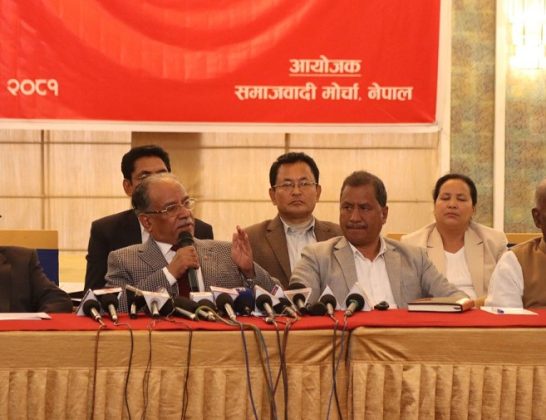‘Season Of Bloom Coming In Nepal-India Ties’
Mahendra P. Lama is a development economist and a professor of international studies at Jawaharlal Nehru University (JNU), New Delhi. He is the founding Vice Chancellor of Sikkim University. At the age of 45, he became India’s youngest university Vice Chancellor at Indira Gandhi National Open University. He was a member of the Eminent Persons Groups (EPG) formed by the prime ministers of Nepal and India in early 2016 to study wider aspects of Nepal-India relations and make recommendations for improved ties.
Born in March 1961 in Darjeeling of India, Lama has an acclaimed academic stature in South Asia. Hailing from a Nepali speaking community, he talks highly about the hard work done to promote the language in India. “Here in Nepal, you may not have that much sense of competition to nurture and promote Nepali language. We have a lot of competitive spirit to raise the status Nepali language in India. We have to beat so many competitors to win a literary award,” he says.
Arpana Adhikari of The Rising Nepal spoke to Professor Lama on various aspects of Nepal-India relations in Kathmandu on Tuesday. Excerpts:
You have been closely observing Nepal-India relations. Can you shed lights on the dimensions of Nepal-India relations in the present context?
Nepal and India share unique ties of friendship that cannot be compared with the relationship of any other two countries. Both the countries share infinite, unique, unfathomable and comprehensive relationship. Nepal is the only country, with which India not just shares geographical borders and government-to-government ties but also people-to-people relations and from environment to agriculture, open border to culture, from water resources to electricity trade, road connectivity to industries, education and health to employment and disaster to climate change management. However, both the countries should now focus on strengthening bilateral ties by addressing all the challenges that has been brought about by technology, globalisation and interferences of the third country.
What are the barriers that lie on1 the way to advance economic and social development between two countries?
Both India and Nepal are independent countries. Being an independent country, national sovereignty and national security are equally important for both India and Nepal, regardless of their size.
A big country like India should respect Nepal’s sovereignty and recognise this core aspect of Nepal’s sensitivity, while, Nepal also needs to free itself from the conventional box of small country syndrome.
There are many things to be done on the part of development. For this, Nepal should also have to think bigger. Nepal and India should now adopt integrated common market policy by maintaining independence and sovereignty of both countries. The concept of integrated common market was also visualised by the Treaty of Trade and Transit between Nepal and India, 1960, and has been followed by North America, European Union, and ASEAN.
India has recently made its commitment at Glasgow Climate Summit to promote clean energy by reducing the use of coal as fuel. Nepal is going to generate more hydropower than it needs. In this context, is it possible for Nepal to get market in India to export its surplus electricity?
Definitely, it is possible. This is not a big issue. It is all about the matter of bilateral agreement. For six decades, both Nepal and India did not show any interest in electricity transmission and trade to India. There was also some obstacle in power trade. Now this barrier has been removed. India has issued new guidelines for cross-border electricity trade, which clears the way for trans-border electricity trade.
For the first time, India has connected its national grid with that of Bangladesh. As per the guideline, there will be no longer barrier to sell electricity even beyond India. India emerges as cross-border electricity trader. It opens the market to Bangladesh, Bhutan, and Myanmar and beyond. If the price of electricity is higher in Bangladesh than in India, Nepal can sell its electricity to Bangladesh through this grid connection.
But Nepali investors fear that the Indian guidelines somehow intend to promote trade of power produced by the company that has Indian investment.
The guidelines issued by India in 2016 and 2018 remained controversial. However, following the objections from Nepal and Bhutan, the Indian government has issued new concrete guidelines in 2021, that clears the way for promoting investment in hydropower project.
Since the SAARC process remained stalled for more than half a decade, it has failed to nurture regional cooperation in South Asia. What are the barriers?
India should have played a crucial role in strengthening regionalism. However, India has failed to take forward the regionalism and boost regional cooperation in South Asia and BIMSTEC. India has remained one of the major reasons to hinder the SAARC summit. The latest SAARC summit has been stalled for seven years. In all, 18 summits were held, 17 summits were not held. India is focusing more on bilateralism than regionalism. This has resulted in the rise of third country interference in the South Asian countries.
Has India given up Gurajal Doctrine which was once so talked about?
India’s Prime Minister Narendra Modi has adopted ‘Neighbourhood first’ policy, which sought to develop better relations with the neighbouring countries. He had clearly mentioned that India would give priority to bilateral connectivity, trade, and cultural-tourism. But the neighbouring countries were never seen appreciated his move. Since PM Modi has come up with such proposals, the neighbouring countries should have taken an initiative to get benefits out of it, according to their needs.
In the last few years, Nepal-India bilateral relation has witnessed new forms of crisis, including the economic blockade and border disputes. What are the ways forward to resolve such problems for good and improve Nepal-India relations?
The economic blockade imposed in 2015 was the third one. Previous blockades were imposed in 1970 and 1988-89. This action triggered a massive anti-Indian sentiment among the young generation in Nepal. This blockade hadn’t given desired results. However, the ongoing border crisis should be resolved by holding bilateral dialogues.
Why is the Indian government reluctant to receive the joint report prepared by the Eminent Persons Group (EPG) prepared two years ago? The report is said to have charted out a future course to improve bilateral ties? What are the major recommendations?
The EPG has already completed its assigned tasks. The group was not only formed to revise the agreement and treaties, including 1950 Treaty of Peace and Friendship but also help reset Nepal-India relations in line with the realities of the 21st century. The EPG recommendations concern trade, commerce, water resources, climate change, sports, pandemic, people-to-people contact, cultural ties among others.
We talked about pandemic in the report even before the coronavirus pandemic came. As per the agreement we have to submit the report first to the Indian Prime Minister and then to Nepal’s Prime Minister.
However due to various reasons, the Indian Prime Minister has not provided us time to receive the report.
What could be the solution to the Nepal-India border dispute in Limpiyadhura? Why is India reluctant to resolve the border dispute?
This is a major issue. Nepal and India have their own stances regarding Limpiyadhura. India and Nepal should take initiative to resolve the border issue through serious diplomatic efforts and dialogues. The talks should be held at the prime minister level. While talking about India’s effort to resolve the border dispute, Indian government’s focus is now shifted to contain the pandemic.
The government has its own procedures and process to forward their works. An instability seen in Nepali politics might be another reason why the Indian government has not forwarded the process to resolve the border-dispute. Who should we be talking to? Since the situation has improved in Nepal now, let us hope the government might forward the process now. The Indo-Nepal relationship cannot deteriorate further. ‘Basanta Ritu (season of bloom) will soon arrive in the Indo-Nepal relationship.
What Nepal and India need to do to improve the relations?
Nepal-India relations should not be primarily government-driven, or we can say Delhi or Kathmandu-driven. The government of both countries should only play a facilitating role and ensure that people and business of the countries interact even more. We have four layers of India-Nepal relations, including government to government, people to people ties, business to business relations and lastly the ties between both countries’ civil societies. Of them the government’s role in improving Nepal-India ties is just 10-15 per cent and the rest lies on people, business communities and civil society.
The government could only formulate policies and the rest of the work to improbe Indo-Nepal relations lies on our hand. We should not depend on the government solely to improve Nepal-India ties because we know how the government functions. We must understand that India is not only Delhi alone and Nepal is not only Kathmandu.
Secondly, we have many positive aspects in Nepal-India ties that needed to be highlighted than the negative prospects. And lastly, Nepal should approach India in a big way, like implementing big projects in Nepal rather than wasting time in minor things.
Being a Nepali speaking national of India, how do you see the situation of Nepali language and Nepali speaking communities in India?
We, the educated Nepali speaking people have been working hard in India to educate the Nepali speaking community. We are in fierce competition with other languages. Here in Nepal, you don’t have a sense of competition for Nepali language. In India we have to work in tough competition with other languages to make our presence. We have to beat so many competitors to win a literary award. In 1992, Nepali language was enlisted in the 8th Schedule of Indian constitution. Nepali word Ek Saya Rupia is printed in Rs. 100 Indian currency note, among other languages of India.












Comments